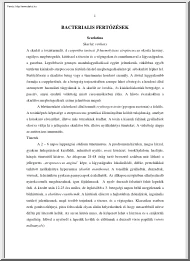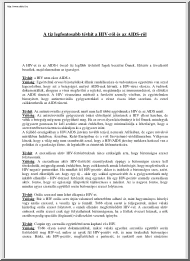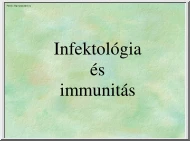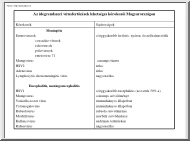Datasheet
Year, pagecount:2020, 5 page(s)
Language:English
Downloads:3
Uploaded:January 26, 2020
Size:702 KB
Institution:
-
Comments:
Attachment:-
Download in PDF:Please log in!
Comments
No comments yet. You can be the first!Most popular documents in this category
Content extract
Source: http://www.doksinet Feline Coronavirus Feline coronavirus (FCoV) infection is common in cats, particularly in multicat households in which up to 90% of cats are seropositive. Although most infections are self-limiting and cause few or only mild gastrointestinal signs, occasionally (in 1-5% of infected cats) the fatal disease of feline infectious peritonitis (FIP) results. Viral, host and environmental factors are thought to contribute to the outcome of infection with FCoV. Control of FCoV infection in cats is desirable in those situations in which FIP has been a problem or, less commonly, if enteric FCoV infection signs (e.g diarrhoea) are particularly prominent *UPDATED INFORMATION Recent research describing specific mutations in the FCoV spike (S) protein (Chang, Egberink et al. 2012) as very specific markers of FCoVs associated with FIP was extremely promising for the diagnosis of FIP. However, work subsequently published by our research group (Porter 2014, Barker 2017)
showed that these S protein mutations were actually markers of systemic FCoV infection, rather than of FIP, and could not confirm a diagnosis of FIP. Barker EN, Stranieri A, Helps CR, Porter EL, Davidson AD, Day MJ, Knowles T, Kipar A & Tasker S (2017). Limitations of using feline coronavirus spike protein gene mutations to diagnose feline infectious peritonitis. Veterinary Research, 48: 60 Chang HW, Egberink HF, Halpin R, Spiro DJ & Rottier PJ (2012). Spike protein fusion peptide and feline coronavirus virulence. Emerging Infectious Diseases, 18: 1089 Porter E, Tasker S, Day MJ, Harley R, Kipar A, Siddell SG & Helps CR (2014). Amino acid changes in the spike protein of feline coronavirus correlate with systemic spread of virus from the intestine and not with feline infectious peritonitis. Veterinary Research, 45: 49 Source: http://www.doksinet Feline Coronavirus FAQs How is FCoV spread? FCoV is shed in the faeces of infected cats and is spread between cats by the
faecal-oral route, with litter trays being the main source of infection. Once shed, FCoV is normally inactivated within 24-48 hours, but can survive up to 7 weeks in dried faeces allowing for indirect transmission via fomites. It is readily destroyed by most household disinfectants and detergents. Our research studies have found that around 2/3 of cats in multicat households shed FCoV in their faeces; levels are higher in kittens compared to adults. FCoV shedding starts soon after infection and can be transient over a few months, recurrent (attributed to cycles of infection, recovery, loss of immunity and then reinfection), or chronic over periods of months or years. Cats that shed FCoV chronically, so-called "chronic shedders", can act as a continuous source of FCoV infection to other cats in the household. Seroconversion occurs approximately 10 days after infection, with titres rising over the following weeks. However, antibodies are unable to clear FCoV infection from the
gut as viral shedding continues in the face of seroconversion. Can FCoV RT-qPCR help me diagnose FIP? FCoV RT-qPCR on faeces is NOT useful for the diagnosis of FIP. The assay amplifies and detects any type of FCoV and is only of use to detect FCoV shedding in cats. However, FCoV RT-qPCR is being increasingly used to amplfy FCoV from effusion or tissue samples taken from cats suspected of having FIP, to try and aid diagnosis. It is known that FIP cases have significantly greater RT-PCR FCoV loads than non-FIP cases, but the presence of FCoV in these samples does not absolutely confirm a diagnosis of FIP since we know that some non-FIP cases can have systemic FCoV, albeit at low levels. However a positive result, particularly with high levels of FCoV, would support a suspected diagnosis of FIP in a cat with appropriate clinical signs. RT-qPCR for FCoV forms part of the FIP profile we offer on pleural or peritoneal fluid to help you diagnose FIP. RT-qPCR for FCoV can also be performed on
CSF samples, to support a diagnosis of FIP in neurological cases. Despite early promise (see *UPDATED INFORMATION above) that PCRs targeting spike protein mutations were helpful in distinguishing FIP-associated FCoVs from non-FIP FCoVs, it is now known that these mutations cannot be used to definitively diagnose FIP. Our Source: http://www.doksinet Feline Coronavirus research has shown that they do not provide additional information over the detection of FCoV in systemic sites by standard FCoV RT-qPCR assays. How do I control FCoV infection? Mortality from FIP in a household tends to increase as the population of animals, especially kittens, increases, and when other concurrent diseases or infections are present. The number of cats housed together should be minimised, keeping cats in small stable groups of less than 6 per group whenever possible. Litter tray hygiene is very important as well as having adequate numbers of litter trays. Genetic resistance/susceptibility to FIP may
also play a role in the incidence of FIP, particularly in breeding cat households; further breeding from individual cats that have produced affected FIP kittens should be avoided. Isolation of pregnant queens just before parturition, and subsequent early weaning of their kittens, has been recommended as a means to control FCoV infection in breeding households. Normally kittens are protected from FCoV infection by maternal derived immunity (MDI) for the first 6 weeks of life, and are then infected with FCoV at around 9-10 weeks of age, when MDI wanes. Isolation and early weaning of kittens at around 4-6 weeks of age means that they are removed from sources of FCoV before their MDI wanes, resulting in the production of FCoV negative kittens. However, the potential behavioural effects of early weaning on the kittens should be considered as well as an appreciation of the amount of work (including cost) involved with early weaning due to the segregation and strict quarantine required for
this procedure; it is not easy to do and may work best in smaller catteries. Additionally FCoV free kittens will often then be rehomed into households or exposed to environments (e.g shows) in which they are exposed to FCoV infection, so it is unlikely that they will remain FCoV infection free for long, although the more adult they are when they encounter FCoV, the less likely they are to develop FIP as a result of infection. How should I use the FCoV test then? The FCoV RT-qPCR assay performed on faeces will identify shedding of FCoV in faeces. It can be used to identify FCoV shedders in breeding homes to help with any FCoV eradication or Source: http://www.doksinet Feline Coronavirus reduction programmes. The test, when repeated over time on an individual cat, can also be used to identify chronic shedders; removal of chronic shedders from a household can help control FCoV infection in that household. Owners of seropositive cats may also wish to test their cats for faecal FCoV
shedding if they are introducing a new cat into the household or are waiting to undertake a potentially stressful event in the cat e.g breeding or neutering Since cats can shed FCoV intermittently, at least 2 faecal samples (and preferably more, as cats can typically shed FCoV for 5 months), collected at monthly intervals should be tested by RT-qPCR to maximise identification of FCoV shedding. The FCoV RT-qPCR assay performed on effusion (abdominal, pleural of pericardial) or tissue or CSF samples will identify the presence of FCoV in these samples and may be helpful in supporting a diagnosis of FIP in cases in which FIP is suspected. Thus cats being tested should have clinical signs consistent with FIP as well as other supportive features such as being young and/or pedigree and having appropriate clinical pathological changes on haematology, serum biochemistry and/or effusion analysis. RT-qPCR for FCoV forms part of the FIP profile we offer on pleural or peritoneal fluid to help you
diagnose FIP. Interpretation of results Chronic shedders will be RT-qPCR positive on faeces at all monthly time points tested; positive results on more than 5 monthly tests indicate that the cat is likely to be a chronic shedder. Cats can be confirmed as being non-shedders by obtaining negative RT-qPCR results on faeces on several sequential monthly tests; ideally 5 sequential tests should be negative, so that intermittent shedders are not incorrectly identified as non-shedders. FIP cases have significantly greater RT-qPCR FCoV loads than non-FIP cases, so the higher the levels (the lower the Ct) identified by RT-qPCR in effusion or tissue or CSF samples, the more supportive the result is of a diagnosis of FIP. However, it must be remembered that nonFIP cases can have systemic FCoV, albeit uncommonly and usually at low levels, and thus can generate a positive RT-qPCR result. We have seen this with tissue samples but not yet effusion or CSF samples, so caution must be exercised in
interpretation of test results. What sort of sample should I send? For faecal RT-qPCR, a small volume (2-5ml) of fresh faeces is required. Please ensure that no cat litter is present. Samples should be kept refrigerated and sent directly to our laboratory, although refrigeration is not required for postage. To ensure the best results possible, samples Source: http://www.doksinet Feline Coronavirus should ideally be received in the laboratory within 3 days of sampling, although positive results have been obtained after lengthier delays. For RT-qPCR on samples collected from cases suspected of having FIP, a small volume of effusion (1 ml), CSF (0.2 ml) or a small amount of fresh or frozen tissue (a trucut biopsy or larger is adequate, within 3 days of sampling) is required. The FCoV RT-qPCR assay is duplexed with an internal amplification control PCR. This is extremely important for diagnostic PCRs, especially those performed on faeces, as this enables detection of any inhibitory
substances, which could cause false negative FCoV RT-qPCR results. PLEASE NOTE - We can only accept faecal samples for FCoV testing from Veterinary Surgeons. We cannot accept samples sent directly from owners or breeders
showed that these S protein mutations were actually markers of systemic FCoV infection, rather than of FIP, and could not confirm a diagnosis of FIP. Barker EN, Stranieri A, Helps CR, Porter EL, Davidson AD, Day MJ, Knowles T, Kipar A & Tasker S (2017). Limitations of using feline coronavirus spike protein gene mutations to diagnose feline infectious peritonitis. Veterinary Research, 48: 60 Chang HW, Egberink HF, Halpin R, Spiro DJ & Rottier PJ (2012). Spike protein fusion peptide and feline coronavirus virulence. Emerging Infectious Diseases, 18: 1089 Porter E, Tasker S, Day MJ, Harley R, Kipar A, Siddell SG & Helps CR (2014). Amino acid changes in the spike protein of feline coronavirus correlate with systemic spread of virus from the intestine and not with feline infectious peritonitis. Veterinary Research, 45: 49 Source: http://www.doksinet Feline Coronavirus FAQs How is FCoV spread? FCoV is shed in the faeces of infected cats and is spread between cats by the
faecal-oral route, with litter trays being the main source of infection. Once shed, FCoV is normally inactivated within 24-48 hours, but can survive up to 7 weeks in dried faeces allowing for indirect transmission via fomites. It is readily destroyed by most household disinfectants and detergents. Our research studies have found that around 2/3 of cats in multicat households shed FCoV in their faeces; levels are higher in kittens compared to adults. FCoV shedding starts soon after infection and can be transient over a few months, recurrent (attributed to cycles of infection, recovery, loss of immunity and then reinfection), or chronic over periods of months or years. Cats that shed FCoV chronically, so-called "chronic shedders", can act as a continuous source of FCoV infection to other cats in the household. Seroconversion occurs approximately 10 days after infection, with titres rising over the following weeks. However, antibodies are unable to clear FCoV infection from the
gut as viral shedding continues in the face of seroconversion. Can FCoV RT-qPCR help me diagnose FIP? FCoV RT-qPCR on faeces is NOT useful for the diagnosis of FIP. The assay amplifies and detects any type of FCoV and is only of use to detect FCoV shedding in cats. However, FCoV RT-qPCR is being increasingly used to amplfy FCoV from effusion or tissue samples taken from cats suspected of having FIP, to try and aid diagnosis. It is known that FIP cases have significantly greater RT-PCR FCoV loads than non-FIP cases, but the presence of FCoV in these samples does not absolutely confirm a diagnosis of FIP since we know that some non-FIP cases can have systemic FCoV, albeit at low levels. However a positive result, particularly with high levels of FCoV, would support a suspected diagnosis of FIP in a cat with appropriate clinical signs. RT-qPCR for FCoV forms part of the FIP profile we offer on pleural or peritoneal fluid to help you diagnose FIP. RT-qPCR for FCoV can also be performed on
CSF samples, to support a diagnosis of FIP in neurological cases. Despite early promise (see *UPDATED INFORMATION above) that PCRs targeting spike protein mutations were helpful in distinguishing FIP-associated FCoVs from non-FIP FCoVs, it is now known that these mutations cannot be used to definitively diagnose FIP. Our Source: http://www.doksinet Feline Coronavirus research has shown that they do not provide additional information over the detection of FCoV in systemic sites by standard FCoV RT-qPCR assays. How do I control FCoV infection? Mortality from FIP in a household tends to increase as the population of animals, especially kittens, increases, and when other concurrent diseases or infections are present. The number of cats housed together should be minimised, keeping cats in small stable groups of less than 6 per group whenever possible. Litter tray hygiene is very important as well as having adequate numbers of litter trays. Genetic resistance/susceptibility to FIP may
also play a role in the incidence of FIP, particularly in breeding cat households; further breeding from individual cats that have produced affected FIP kittens should be avoided. Isolation of pregnant queens just before parturition, and subsequent early weaning of their kittens, has been recommended as a means to control FCoV infection in breeding households. Normally kittens are protected from FCoV infection by maternal derived immunity (MDI) for the first 6 weeks of life, and are then infected with FCoV at around 9-10 weeks of age, when MDI wanes. Isolation and early weaning of kittens at around 4-6 weeks of age means that they are removed from sources of FCoV before their MDI wanes, resulting in the production of FCoV negative kittens. However, the potential behavioural effects of early weaning on the kittens should be considered as well as an appreciation of the amount of work (including cost) involved with early weaning due to the segregation and strict quarantine required for
this procedure; it is not easy to do and may work best in smaller catteries. Additionally FCoV free kittens will often then be rehomed into households or exposed to environments (e.g shows) in which they are exposed to FCoV infection, so it is unlikely that they will remain FCoV infection free for long, although the more adult they are when they encounter FCoV, the less likely they are to develop FIP as a result of infection. How should I use the FCoV test then? The FCoV RT-qPCR assay performed on faeces will identify shedding of FCoV in faeces. It can be used to identify FCoV shedders in breeding homes to help with any FCoV eradication or Source: http://www.doksinet Feline Coronavirus reduction programmes. The test, when repeated over time on an individual cat, can also be used to identify chronic shedders; removal of chronic shedders from a household can help control FCoV infection in that household. Owners of seropositive cats may also wish to test their cats for faecal FCoV
shedding if they are introducing a new cat into the household or are waiting to undertake a potentially stressful event in the cat e.g breeding or neutering Since cats can shed FCoV intermittently, at least 2 faecal samples (and preferably more, as cats can typically shed FCoV for 5 months), collected at monthly intervals should be tested by RT-qPCR to maximise identification of FCoV shedding. The FCoV RT-qPCR assay performed on effusion (abdominal, pleural of pericardial) or tissue or CSF samples will identify the presence of FCoV in these samples and may be helpful in supporting a diagnosis of FIP in cases in which FIP is suspected. Thus cats being tested should have clinical signs consistent with FIP as well as other supportive features such as being young and/or pedigree and having appropriate clinical pathological changes on haematology, serum biochemistry and/or effusion analysis. RT-qPCR for FCoV forms part of the FIP profile we offer on pleural or peritoneal fluid to help you
diagnose FIP. Interpretation of results Chronic shedders will be RT-qPCR positive on faeces at all monthly time points tested; positive results on more than 5 monthly tests indicate that the cat is likely to be a chronic shedder. Cats can be confirmed as being non-shedders by obtaining negative RT-qPCR results on faeces on several sequential monthly tests; ideally 5 sequential tests should be negative, so that intermittent shedders are not incorrectly identified as non-shedders. FIP cases have significantly greater RT-qPCR FCoV loads than non-FIP cases, so the higher the levels (the lower the Ct) identified by RT-qPCR in effusion or tissue or CSF samples, the more supportive the result is of a diagnosis of FIP. However, it must be remembered that nonFIP cases can have systemic FCoV, albeit uncommonly and usually at low levels, and thus can generate a positive RT-qPCR result. We have seen this with tissue samples but not yet effusion or CSF samples, so caution must be exercised in
interpretation of test results. What sort of sample should I send? For faecal RT-qPCR, a small volume (2-5ml) of fresh faeces is required. Please ensure that no cat litter is present. Samples should be kept refrigerated and sent directly to our laboratory, although refrigeration is not required for postage. To ensure the best results possible, samples Source: http://www.doksinet Feline Coronavirus should ideally be received in the laboratory within 3 days of sampling, although positive results have been obtained after lengthier delays. For RT-qPCR on samples collected from cases suspected of having FIP, a small volume of effusion (1 ml), CSF (0.2 ml) or a small amount of fresh or frozen tissue (a trucut biopsy or larger is adequate, within 3 days of sampling) is required. The FCoV RT-qPCR assay is duplexed with an internal amplification control PCR. This is extremely important for diagnostic PCRs, especially those performed on faeces, as this enables detection of any inhibitory
substances, which could cause false negative FCoV RT-qPCR results. PLEASE NOTE - We can only accept faecal samples for FCoV testing from Veterinary Surgeons. We cannot accept samples sent directly from owners or breeders





